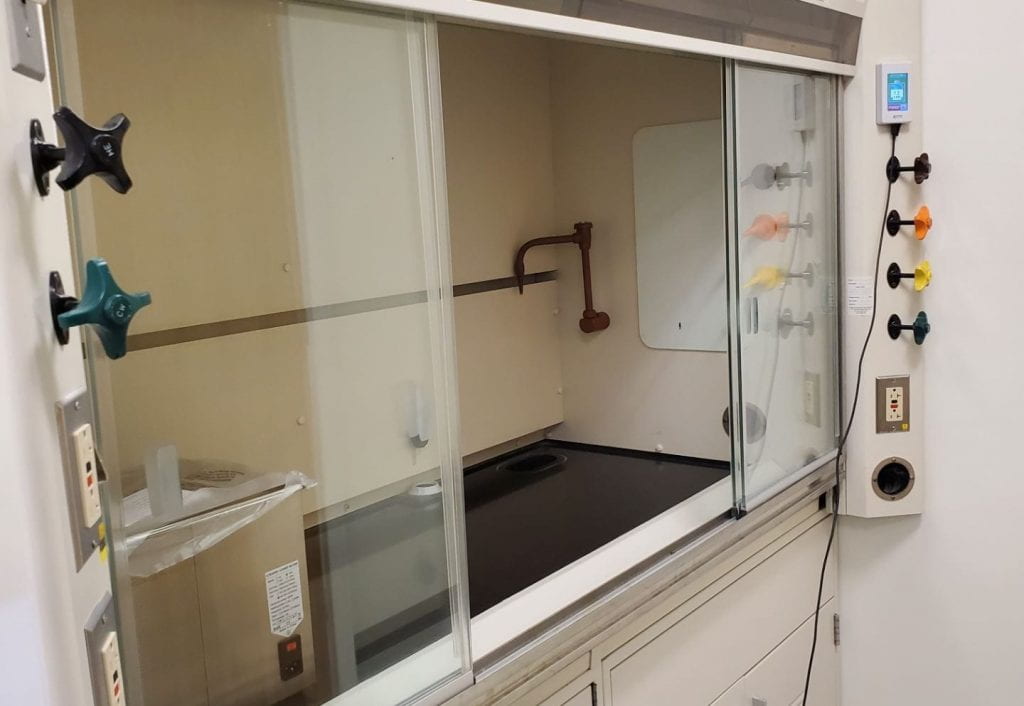By Jarea Fang
Labs account for over 1.6 million square feet of space across WashU’s campuses, and in some cases, they can use 5 to 10 times the amount of energy an office space does. Lab energy use comes from built-in equipment and systems, such as specialty HVAC units, humidification systems, and more; these systems, for the most part, have to use a certain amount of energy to function and keep lab spaces running smoothly and safely. However, there is a huge opportunity to reduce lab energy use when it comes to equipment that we plug in and large equipment that we use daily – like fume hoods.
A fume hood is a ventilated enclosure in which gases, vapors and fumes are contained. An exhaust fan situated on the top of the laboratory building pulls air and airborne contaminants through connected ductwork and exhausts them to the atmosphere. When used properly, fume hoods are one of the most reliable laboratory equipment for keeping research personnel safe.
In order for a fume hood to exhaust a given volume of air, a central air handling unit needs to heat or cool that air to 55° and dehumidify it in the summer. Then, it needs to push the air through the ductwork to the lab, and powerful fans will exhaust the air on the roof. This requires a tremendous amount of heating and cooling energy, which makes fume hoods easily one of the most energy exhaustive equipment in the laboratory setting. Any decrease in the amount of air to exhaust will save a lot of energy, and the easiest way to decrease the air is to close the sash in front of the hood, which will create a barrier between the fume hood and the rest of the air-conditioned room. Closing fume hood sashes when not in use is required by Environmental Health & Safety, not only because of potential energy savings, but because it is an important safety protocol. Keeping the sashes closed when not in use reduces the chance of injury from unintended reactions or spills.
In 2005, Harvard University started the Shut the Sash Program to remind lab researchers to always close the sash in front of fume hoods whenever they are not in use. This green labs practice has saved more energy than any other behavior program at Harvard to date, and similar incentive programs have made their way into many sustainability-minded institutions, WashU included.
Shutting the Sash at WashU
Labs account for a large portion of energy use at WashU. This is especially important when considering the primary source of energy in the state of Missouri is still coal, a fossil fuel. Therefore, as a university that places sustainability as one of its top priorities, this simple but high-impact green labs practice is one of the easiest ways to reduce the carbon footprint of our labs.
“Based on current estimates, there are approximately 615 fume hoods on the Danforth Campus alone,” says Angela Dartt, the Director of the Office of Chemical Safety. HVAC Services Manager, Craig England shares that hood size and flow rate vary across campus and the dollar cost of leaving a single hood open can be anywhere from $600 to $2,000 per year. “There are different size hoods across campus, and flow rates vary. The dollar cost of leaving a single hood open can be anywhere from $600-$2000 per year.”
Not only is there a reminder to shut the sash on WashU’s Green Labs website, a team of personnel from Environmental Health and Safety (EH&S), Facilities Planning and Management (Facilities), Engineering, and Chemistry departments have put a lot of study and research into developing standards for our fume hoods.
For example, by selecting the right manufacturers and equipment, labs are able to maximize safety without using excessive energy, and when appropriate, hoods can be operated with variable volume to take advantage of energy savings from closing the sash. On the Danforth campus, many of the newer fume hoods are also connected to the campus Building Automation System (BAS), allowing Facilities to monitor the fume hood sash positions in order to identify those that have not been closed completely during idle hours. Most importantly, the departments and EH&S work hard to educate incoming students and new researchers about both the safety and sustainability aspects of proper fume hood operation.
Facilities and EH&S note that most experienced lab personnel do a good job of shutting the sash. The true challenge is that there are new students and researchers in many of the labs every year, and they may not be as conscientious about shutting the sash. Overall, the university has seen substantial improvements from working closely with the departments and labs this way.
Resources for Fume Hoods
It’s important that both our safety and energy-saving efforts do not go to waste due to a poorly-maintained fume hoods. Please see the instructions below for any maintenance needs:
- If you are located on Danforth Campus, please contact your building zone manager and other applicable School or Department contacts for maintenance.
- If you are located on the Medical Campus, please submit a work order through Facilities Integrated Service Center (FISC) for maintenance.
- If there are any questions or concerns regarding the safety of your fume hood, please reach out to your EH&S contact or the EH&S Department at (314)362-6816 or ehs@wustl.edu.
- Lastly, EH&S will be putting the stickers on all fume hoods across campuses. For other lab signage, check out the Green Labs webpage.
Further Research
- Use of Chemical Fume Hood – EH&S
- Laboratory Safety Chemical Fume Hoods – OSHA QuickFacts
- Green Labs Resources – WashU Office of Sustainability
- Shut the Sash Program – Harvard University
- Shut the Sash Video – CSIRO
